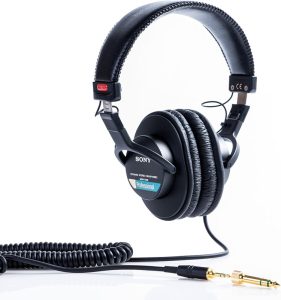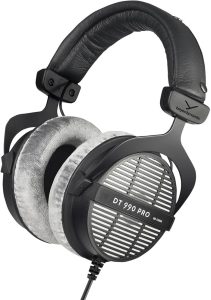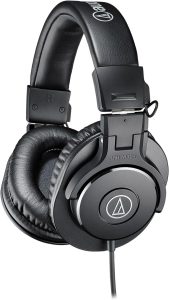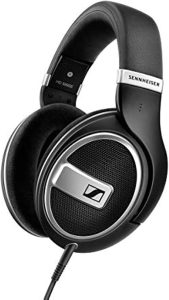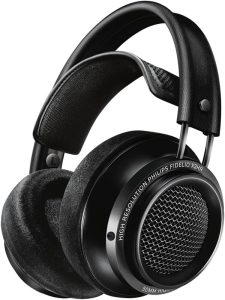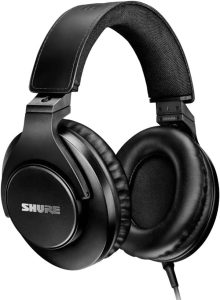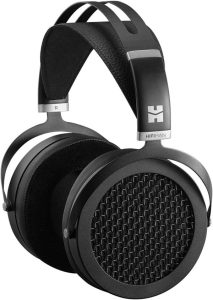For mixing, mastering, and general music production, studio monitors are commonly used. However, for a more personal listening experience and to fine-tune music, many professionals prefer high-quality studio headphones. The market offers a wide array of studio headphones, but it’s crucial to find ones that accurately deliver the full audio spectrum and remain comfortable over long periods.
When choosing headphones for these critical tasks, consider several important factors to ensure they fulfill the requirements:
- Driver Size: The driver size, or the diameter of the headphone’s speaker element, is essential. Larger drivers typically provide a richer, more detailed sound, especially in the bass frequencies. A minimum driver size of 30mm is advisable for mixing and mastering.
- Impedance: This represents the electrical resistance of the headphones. Headphones with higher impedance need more power, often requiring a headphone amplifier. An impedance range of 32-80 ohms strikes a good balance for these activities.
- Sensitivity: This measures how efficiently headphones convert electrical signals into sound. Headphones with higher sensitivity produce a louder output for less power, while those with lower sensitivity might need more power for the same volume level. Look for headphones with a sensitivity of at least 90 dB.
With the plethora of options available, selecting the right headphones for mixing and mastering can be daunting. Our “Buying Guide” is designed to assist you in navigating these choices to find the headphones best suited to your needs.
Outline
Toggle- Best Headphones for Mixing and Mastering Table
- Best Headphones for Mixing and Mastering Reviews
- 1. Sony Headphones for Mixing and Mastering
- 2. Beyerdynamic Headphones for Mixing and Mastering
- 3. Audio-Technica Headphones for Mixing and Mastering
- 4. Sennheiser Headphones for Mixing and Mastering
- 5. PHILIPS Headphones for Mixing and Mastering
- 6. Shure Headphones for Mixing and Mastering
- 7. HIFIMAN Headphones for Mixing and Mastering
- Buying Guide for Best Headphones for Mixing and Mastering
- Headphones for Mixing and Mastering – FAQs
- Conclusion
Best Headphones for Mixing and Mastering Table
| Best Headphones for Mixing and Mastering | Driver Size | Impedance | Sensitivity | Buy Now |
|---|---|---|---|---|
| Sony Headphones for Mixing and Mastering | 40mm | 63 Ohms | 106dB | Check On Amazon |
| Beyerdynamic Headphones for Mixing and Mastering | - | 250 Ohms | 96 dB | Check On Amazon |
| Audio-Technica Headphones for Mixing and Mastering | 40mm | 47 Ohms | 96 dB | Check On Amazon |
| Sennheiser Headphones for Mixing and Mastering | 50mm | 50 Ohms | 106dB | Check On Amazon |
| PHILIPS Headphones for Mixing and Mastering | - | 30 Ohms | 100 dB | Check On Amazon |
| Shure Headphones for Mixing and Mastering | 40mm | 40 Ohms | 97 dB | Check On Amazon |
| HIFIMAN Headphones for Mixing and Mastering | - | 32 Ohms | 94 dB | Check On Amazon |
Best Headphones for Mixing and Mastering Reviews
1. Sony Headphones for Mixing and Mastering
When we put Sony’s MDR stereo headphones to the test, we were thoroughly impressed for several reasons. The exceptional sound quality stood out immediately, captivating us with its clarity and depth. Featuring neodymium magnets and 40mm drivers, these headphones deliver an immersive audio experience that spans a wide frequency range from 10Hz to 20kHz, ensuring every note is crisp and vibrant.
The closed-ear design effectively blocks out external noise, making them ideal for both studio professionals and casual listeners alike. Additionally, the Stereo Unimatch plug accommodates both 1/4-inch and 1/8-inch jacks, adding to their versatility. With a 9.8-foot coiled cord, these headphones offer flexibility and freedom of movement without sacrificing convenience. They also come with a soft protective case for easy storage and transport. Designed with comfort in mind, including padded headbands, and constructed for durability, these headphones are sure to satisfy the discerning tastes of music enthusiasts and professionals alike.
Features:
- Type: Closed Back.
- Driver Size: 40mm.
- Impedance: 63 Ohms.
- Frequency Response: 10Hz-20 kHz.
- Sensitivity: 106 dB.
- Connectivity: 3.5mm,6.5mm adapter.
- Cable Length: 9.8ft.
Pros:
- Excellent sound quality for the price.
- Rugged and durable.
- Widely used by professionals.
Cons:
- Not the most stylish headphones.
2. Beyerdynamic Headphones for Mixing and Mastering
The DT 990 PRO by Beyerdynamic closely rivals Sony’s MDR, boasting exceptional sound quality. However, in terms of noise cancellation, the MDR outperforms it. Distinguished by its open-back, around-the-ear design, these headphones offer detailed, clear, and spacious sound, perfect for professional tasks like mixing, mastering, editing, and attentive listening. Thanks to this design, they provide a broad soundstage, offering an immersive audio experience that feels lifelike.
Moreover, the DT 990 PRO excels in delivering precise bass and crisp treble, ensuring a rich and detailed sound across all frequencies. Comfort is prioritized with a durable steel headband and adjustable, soft ear cups, allowing for extended wear without discomfort. Additionally, the single-sided cable minimizes tangles and simplifies adjustments, enhancing user-friendliness.
Features:
- Type: Open Back.
- Impedance: 80 Ohms.
- Frequency Response: 5Hz-35 kHz.
- Sensitivity: 96 dB.
- Connectivity: 3.5mm,6.5mm adapter.
- Cable Length: 9.8ft.
Pros:
- Spacious, detailed soundstage.
- Comfortable fit for extended wear.
- Durable construction.
- Wide frequency response.
- High sensitivity.
- Replaceable ear pads.
Cons:
- Non-removable cable can be a drawback for some users.
3. Audio-Technica Headphones for Mixing and Mastering
Now, claiming the third position is the ATH-M30x by Audio-Technica, renowned for their professional monitor headphones that offer an exceptional audio experience with a focus on sound clarity and isolation, ideal for studio tasks, mixing, and field recording. Equipped with 40mm drivers featuring rare earth magnets and copper-clad aluminum wire voice coils, these headphones deliver an extensive frequency range and remarkable detail, specifically tailored to enhance mid-range frequencies for precise audio reproduction.
Apart from its outstanding sound performance, the ATH-M30x prioritizes comfort and convenience for users. Designed with an around-the-ear build and a single-side cable, they ensure comfort even during prolonged use. Furthermore, their foldable design enhances portability, making them effortless to carry. These attributes render the ATH-M30x a versatile option catering to both professionals and audiophiles.
Features:
- Type: Closed Back.
- Driver Size: 40mm.
- Impedance: 47 Ohms.
- Frequency Response: 15Hz-22 kHz.
- Sensitivity: 96 dB.
- Connectivity: 3.5mm,6.5mm adapter.
- Cable Length: 9.8ft.
Pros:
- Delivers exceptional audio clarity and detail.
- Durable and well-built.
- Isolate sound well, even in loud environments.
Cons:
- The ear cups are a bit shallow and may not fit all ears comfortably.
4. Sennheiser Headphones for Mixing and Mastering
Sennheiser is a top contender in the audio market, particularly with its HD 599 special edition headphones, renowned for their sophisticated design and stellar performance. These over-ear headphones boast an open-back design that offers an exceptional auditory journey, characterized by expansive soundscapes and intricate audio detail that even discerning audiophiles will appreciate. At the heart of their excellence lies Sennheiser’s distinctive transducer technology and the innovative Ergonomic Acoustic Refinement (E.A.R) design, working in tandem to produce a harmonized and deeply engaging sound.
The open-back configuration further elevates the listening experience, enveloping you entirely in your music. Moreover, comfort is prioritized with the HD 599 SE headphones. Crafted to be lightweight, they feature velour-covered ear pads and a padded headband, ensuring prolonged listening sessions remain enjoyable. For added convenience, these headphones come equipped with two detachable cables, ensuring seamless compatibility with both home entertainment setups and portable devices.
Features:
- Type: Closed Back.
- Impedance: 47 Ohms.
- Frequency Response: 15Hz-22 kHz.
- Sensitivity: 96 dB.
- Connectivity: 3.5mm,6.5mm adapter.
- Cable Length: 9.8ft.
Pros:
- Comfortable fit for extended wear.
- Versatile connectivity for use with various devices.
- Durable construction with high-quality materials.
Cons:
- Non-removable ear pads limit customization options.
5. PHILIPS Headphones for Mixing and Mastering
The Philips Fidelio X2HR headphones are certified for high-resolution audio, which means they can play a wide range of sounds very clearly. They have large 50mm drivers made from neodymium, which is a material known for its ability to produce high-quality sound. Some of the headphones’ special features include speaker plates that are slightly tilted to make sure the sound hits your ears just right and a headband that adjusts itself to fit you comfortably.
The ear pads are made from memory foam and covered in velour, while the headband is covered in genuine leather, which adds to the premium feel and comfort. For added convenience, these headphones come with a detachable cable that is free from oxygen to maintain sound quality, an adapter to switch between different audio sources, and a clip to keep the cable organized. They can play sounds ranging from very low to very high frequencies (5 – 40,000 Hz), have a sensitivity of 100 dB, and an impedance of 30 Ohms, making them versatile for both music enthusiasts and professionals in either home or studio environments.
Features:
- Type: Open Back.
- Driver Size: 50mm.
- Impedance: 30 Ohms.
- Frequency Response: 5Hz-40 kHz.
- Sensitivity: 100 dB.
- Connectivity: 3.5mm,6.5mm adapter.
- Cable Length: 9.8ft.
Pros:
- Unparalleled audio quality for music lovers and audiophiles.
- Comfortable fit for extended listening sessions.
- Durable construction for long-lasting use.
- Versatile for home listening and studio use.
Cons:
- Not as portable as closed-back headphones due to their open design.
6. Shure Headphones for Mixing and Mastering
The Shure SRH440A Professional Studio Headphones deliver precise and clear sound, ideal for tasks such as podcasting, recording, and mastering. They excel in providing an authentic audio experience, faithfully reproducing sounds across a wide frequency range. Users can expect clear and natural sound reproduction, capturing every detail accurately. Apart from their sound quality, these headphones prioritize comfort and durability.
Featuring a lightweight headband and adjustable ear cups, they ensure comfort during extended listening sessions. Specifically optimized for professional use, the SRH440A headphones are finely tuned to complement a variety of professional audio equipment. This optimization results in enhanced frequency response, impedance, and power handling, making them highly effective for recording and mixing applications, delivering consistent performance across diverse settings.
Features:
- Type: Open Back.
- Driver Size: 40mm.
- Impedance: 40 Ohms.
- Frequency Response: 10Hz-20 kHz.
- Sensitivity: 97 dB.
- Connectivity: 3.5mm,6.5mm adapter.
- Cable Length: 9.8ft.
Pros:
- Ideal for studio monitoring and critical listening.
- Comfortable fit for extended listening sessions.
- Durable construction that can withstand constant use.
- Compatible with a wide range of professional audio devices.
Cons:
- Not suitable for casual listening or everyday use.
7. HIFIMAN Headphones for Mixing and Mastering
The esteemed brand HIFIMAN has crafted these headphones with an 80% thinner diaphragm compared to previous models, resulting in a broader frequency response for an exceptional music experience. Featuring a stylish matte black finish and a weight-distributing strap, the Sundara headphones combine aesthetics with functionality.
The durability of this headphone is further bolstered by an all-metal headband and a new 3.5mm headphone connector, ensuring resilience for everyday use. With a frequency response spanning from 6Hz to 75kHz, these headphones deliver superior sound quality, catering to audiophiles and those seeking comfort, style, and cutting-edge technology in their audio devices.
Features:
- Type: Open Back.
- Impedance: 32 Ohms.
- Frequency Response: 6Hz-75 kHz.
- Sensitivity: 94 dB.
- Connectivity: 3.5mm,6.5mm adapter.
- Cable Length: 9.8ft.
Pros:
- Excellent sound quality.
- Comfortable and stylish design.
- Durable construction.
Cons:
- Not as isolating as some other headphones.
Buying Guide for Best Headphones for Mixing and Mastering
When selecting the best headphones for mixing and mastering, it’s imperative to consider several technical specifications that directly impact their performance and suitability for professional audio work. Understanding these specifications can help you make an informed decision, ensuring that the headphones you choose meet your needs for accuracy, detail, and durability. Here are critical factors to consider:
1. Driver Size
Why it Matters: The driver size in headphones is a key factor affecting their sound quality and the breadth of the frequency range they can reproduce. Larger drivers are generally capable of delivering a richer, more detailed sound with better bass response. This is crucial for mixing and mastering, as it allows audio engineers to hear all elements of a track clearly.
What to Look For: Look for headphones with a driver size of at least 40mm. This size is typically sufficient to provide a broad frequency range and detailed sound reproduction. Some high-end headphones may offer even larger drivers, which could further enhance the listening experience, especially in the low-end frequency range.
2. Impedance
Why it Matters: Impedance measures the electrical resistance of the headphones. Higher-impedance headphones require more power to deliver high audio levels, which usually translates to better sound quality and is an indicator that the headphones are suited for professional use. Low-impedance headphones, while easier to drive with portable devices, may not offer the same level of clarity and detail as their high-impedance counterparts.
What to Look For: For mixing and mastering purposes, headphones with an impedance of 80 ohms or higher are recommended. These headphones are designed to be used with professional audio equipment that can provide the necessary power output. They ensure minimal distortion and a clear, detailed sound, essential for identifying and correcting subtle nuances in the mix.
3. Sensitivity
Why it Matters: Sensitivity measures how efficiently headphones convert an electrical signal into an audible sound. It directly impacts the volume level that the headphones can achieve. In a studio setting, where precision is key, having headphones that can deliver a clean and loud enough sound without distortion is crucial for identifying fine details in the mix.
What to Look For: Headphones with a sensitivity rating of around 90 to 110 dB are ideal for mixing and mastering. This sensitivity range ensures that the headphones can produce a sufficiently loud sound without requiring excessive power, which could otherwise introduce noise and distortion. It’s a delicate balance; too high sensitivity might lead to easier distortion at high volumes, while too low could make it hard to hear subtleties at lower volumes.
4. Frequency Response
Why it Matters: Frequency response refers to the range of audio frequencies a pair of headphones can reproduce. It’s typically measured in Hertz (Hz), ranging from the very low bass frequencies up to the highest frequencies detectable by the human ear. For mixing and mastering, a wide and flat frequency response is crucial because it ensures that the headphones can accurately reproduce all parts of the audio spectrum without artificially boosting or cutting any frequencies. This accuracy is vital for making informed decisions about the mix and master of a track.
What to Look For: Look for headphones that offer a frequency response range from at least 20 Hz to 20 kHz, which is the standard range of human hearing. However, more important than the range is the flatness of the response within this range. Some headphones may emphasize certain frequencies (e.g., bass-heavy headphones), which can mislead during mixing and mastering. Ideally, seek out specifications or reviews that discuss the headphone’s frequency response curve to ensure it is as flat as possible for accurate sound reproduction.
5. Cord Length
Why it Matters: The length of the headphone cord can significantly impact convenience and mobility in the studio. A cord that’s too short may limit your ability to move around your workspace, while a very long cord can become tangled or cause accidents. Moreover, the quality of the cord can affect the signal integrity, potentially introducing noise or signal loss in analog connections.
What to Look For: For studio use, a cord length of around 3 meters (approximately 10 feet) is often ideal, offering enough slack for movement without excessive tangling. Also, consider headphones with detachable or replaceable cords for greater flexibility and durability. Some high-quality headphones offer different cable options, including coiled cords that offer stretchability or straight cords of various lengths.
6. Driver Type
Why it Matters: The driver in headphones is the element that converts electrical signals into sound. The type of driver affects the sound quality, including aspects like clarity, frequency response, and the ability to reproduce dynamics accurately. Different driver types offer unique advantages and can significantly influence the listening experience during mixing and mastering.
a. Dynamic Drivers
What to Look For: Dynamic drivers are the most common and are known for their robust bass response and overall versatility. They work using a magnet, voice coil, and a diaphragm. For mixing and mastering, look for high-quality dynamic driver headphones that offer a well-balanced sound and good transient response. These are often less expensive than other types and can provide excellent value.
b. Planar Magnetic Drivers
What to Look For: Planar magnetic drivers use a thin diaphragm between magnets to produce sound. They are prized for their accuracy and detail across a wide frequency range, making them excellent for critical listening. When choosing planar magnetic headphones, ensure they have a reputation for a flat frequency response and detail clarity. These tend to be pricier but are worth the investment for their precision.
c. Electrostatic Drivers
What to Look For: Electrostatic drivers offer the highest level of detail and transparency by using an electrically charged diaphragm placed between two conductive plates. These headphones require special amplifiers but provide unparalleled accuracy and detail. If opting for electrostatic headphones, look for models known for their flat frequency response and wide dynamic range. These are typically the most expensive, suited for the most discerning ears and professional settings
7. Comfort and Fit
Why it Matters: Mixing and mastering sessions can last several hours, making comfort and fit critical aspects of headphone selection. Ill-fitting or uncomfortable headphones can cause fatigue, distractions, or even pain, negatively impacting the critical listening process and your overall productivity.
What to Look For: Look for headphones with ample padding on the headband and ear cups, made from materials that won’t cause irritation over time. The headphones should have an adjustable headband to accommodate different head sizes and shapes. Weight is also a factor; lighter headphones reduce strain during long sessions. Test the clamping force to ensure it’s snug enough to stay in place without causing discomfort.
8. Form Factor
The form factor of headphones significantly influences their sound profile and suitability for mixing and mastering environments.
a. Open-Back Headphones
Why it Matters: Open-back headphones feature a design that allows air and sound to pass freely through the ear cups. This design provides a more natural and spacious soundstage, which is ideal for accurately judging mix depth and imaging. However, they also allow ambient noise to enter and sound to leak out, which can be problematic in noisy environments.
What to Look For: For critical listening in quiet environments, open-back headphones are preferred. They should offer a comfortable fit, a wide frequency response, and a natural soundstage. Ensure that their spatial representation aligns with your monitoring needs.
b. Closed-Back Headphones
Why it Matters: Closed-back headphones have a sealed ear cup design, which significantly reduces sound leakage and blocks ambient noise. This makes them suitable for use in noisier environments or when privacy is needed. However, they can sometimes produce a more ‘in the head’ soundstage compared to open-back designs.
What to Look For: When selecting closed-back headphones for mixing and mastering, choose models known for their accurate sound reproduction and minimal coloration. Comfort is also important, as the sealed design can increase ear warmth over time.
9. Plug Size
Why it Matters: The plug size determines how the headphones connect to your audio devices. Ensuring compatibility with your equipment is essential to avoid unwanted signal degradation or the need for adapters that can introduce additional points of failure.
What to Look For: Most professional audio equipment uses a 1/4-inch (6.35mm) jack, while consumer electronics typically use a 1/8-inch (3.5mm) jack. Look for headphones that come with a 1/4-inch plug and preferably include a 1/8-inch adapter to ensure versatility across different devices. Gold-plated connectors are a plus, as they offer better resistance to corrosion and generally provide a more reliable connection.
10. Durability
Why it Matters: Professional headphones are an investment. Given the demanding environment of studio work, including regular handling, adjustments, and sometimes even travel, durability ensures that your investment will last, providing value over time without frequent replacements.
What to Look For: High-quality materials and build construction are key indicators of durability. Metal components are generally more durable than plastic, though high-grade plastics can also be robust. Look for replaceable parts, such as ear pads and cables, which can extend the life of your headphones significantly. Reviews and user feedback can offer valuable insights into the longevity and build quality of specific models.
Headphones for Mixing and Mastering – FAQs
Ans: In our opinion, using headphones is better for checking the quality of the music during mastering. They’re closer to your ears and block out room sounds, which helps you catch any issues and artifacts more effectively than using speakers.
Ans: The ideal listening level falls within the range of 70dB to 85dB. This is crucial regardless of your listening method, but it’s especially important when using headphones, as the headphone drivers are very close to your ears.
Ans: When you’re mixing, it’s best to use good studio monitors in a treated room. But if you’re in a room without acoustic treatment or need to mix quietly at night or on the go, headphones can be a good option.
Ans: Open-back headphones are typically favored for mixing because they offer a more accur ate representation of the original sound by not boosting low frequencies. They can be the most comfortable and productive choice, especially when mixing in a quiet studio for extended periods.
Ans: While it’s feasible to complete certain music production tasks with Bluetooth headphones, the increased latency makes us advise against using them for recording live performances of any kind.
Conclusion
In conclusion, selecting the right headphones is key to achieving high-quality results in mixing and mastering. The ideal headphones should offer precise sound reproduction, cover a broad range of frequencies, and be comfortable enough for prolonged use. Based on our thorough evaluation, we recommend the following headphones for mixing and mastering purposes if you’re still confused as to what to buy:
- Sony Headphones: These closed-back headphones provide a balanced audio experience with a focus on midrange frequencies, which is essential for spotting and adjusting any imbalances in mixes. Their lightweight and comfortable design ensures you can work for long hours without discomfort.
- Audio-Technica Headphones: Known for their clear and dynamic sound, these closed-back headphones are both affordable and durable, making them an excellent option for audio engineers on a budget.
- PHILIPS Headphones: Offering an expansive soundstage and detailed audio, these open-back headphones are ideal for critical listening tasks. They combine comfort with sturdy construction, suitable for both professional settings and home studios.
Your choice of headphones should ultimately align with your specific requirements, including your budget, the genre of music you typically work with, and your working environment.

